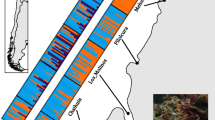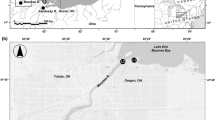Abstract
Allelic frequencies at three polymorphic, enzyme-encoding gene loci (GOT-2, EST-1, EST-2) were determined for Callinectes sapidus (Rathbun) megalopae and adults sampled along the Texas coast of the Gulf of Mexico. Significant temporal and spatial variation was observed at all three loci. Primary findings included: (1) megalopal allelic frequencies often differed significantly from those observed among neighboring adult populations; (2) larval allelic frequencies appeared to vary seasonally, with populations showing sharp differences in the summer months but tending to be more homogeneous in winter; (3) allelic frequencies among adult populations were significantly heterogeneous, but only one locus (EST-2) showed significant temporal variation; (4) juvenile and adult crabs sampled within one bay showed no size-specific differences in allelic frequencies. The spatial heterogeneity in allelic frequencies suggests that interpopulation gene flow is not sufficient to overcome population differentiation resulting from genetic drift and/or natural selection. Temporal variation in larval allelic frequencies suggests seasonal changes in larval source populations which may result from population differences in spawning season or developmental times or from seasonal changes in coastal current patterns.
Similar content being viewed by others
Literature cited
Berger, E. (1973). Gene-enzyme variation in three sympatric species of Littorina. Biol. Bull. mar. biol. Lab., Woods Hole 143: 83–90
Berger, E. (1977). Gene-enzyme variation in three sympatric species of Littorina. II: The Roscoff population, with a note on the origin of North American L. littorea. Biol. Bull. mar. biol. Lab., Woods Hole 153: 255–264
Bookhout, C. G., Costlow, J. D. (1977). Larval development of Callinectes similis reared in the laboratory. Bull. mar. Sci. 27: 704–728
Burton, R. S. (1983). Protein polymorphisms and genetic differentiation of marine invertebrate populations. Mar. Biol. Lett. 4: 193–206
Burton, R. S. (1986). Evolutionary consequences of restricted gene flow in the intertidal copepod Tigriopus californicus. Bull. mar. Sci. 39: 526–535
Burton, R. S., Feldman, M. W. (1981). Population genetics of Tigriopus californicus: II. Differentiation among neighboring populations. Evolution 35: 1192–1205
Burton, R. S., Feldman, M. W. (1982). Population genetics of coastal and estuarine invertebrates: does larval behavior influence population structure? In: Kennedy, V. S. (ed.) Estuarine comparisons. Academic Press, New York, p. 537–551
Cochrane, J. D., Kelly, F. J. (1986). Low-frequency circulation on the Texas-Louisiana continental shelf. J. geophys. Res. 91: 10 645–10 659
Cole, M. A., Morgan, R. P. (1978). Genetic variation in two populations of blue crab, Callinectes sapidus. Estuaries 1: 202–205
Costlow, J. D., Jr., Bookhout, C. G. (1959). The larval development of Callinectes sapidus Rathbun reared in the laboratory. Biol. Bull. mar. biol. Lab., Woods, Hole 116: 373–396
Crisp, J. D. (1978). Genetic consequences of different reproductive strategies in marine invertebrates. In: Battaglia, B., Beardmore, J. (eds.) Marine organisms: genetics, ecology, and evolution. Plenum, New York, p. 257–273
Daugherty, F. M., Jr. (1952). The blue crab investigation, 1949–1950. Tex. J. Sci. 4: 77–84
Gooch, J. L. (1975). Mechanisms of evolution and population genetics. In: Kinne, O. (ed.) Marine ecology. Vol. II: Physiological mechanisms. Wiley, London, p. 349–409
Hartl, D. L., Clark, A. G. (1989). Principles of population genetics, 2nd edn. Sinauer, Sunderland, Massachusetts
Hedgecock, D. (1986). Is gene flow from pelagic larval dispersal important in the adaptation and evolution of marine invertebrates? Bull. mar. Sci. 39: 550–564
Jaworski, E. (1972). The blue crab fishery, Batataria Estuary, Louisiana. Louisana State University Baton Rouge (Sea Grant Publ. No. LSU-SG-72-01)
Johnson, D. F., Hess, K. W. (1990). Numerical simulations of blue crab larval dispersal and recruitment. Bull. mar. Sci. 46: 195–213
Koehn, R. K., Newell, R. I. E., Immermann, F. (1980). Maintenance of an aminopeptidase allele frequency cline by natural selection. Proc. natn. Acad. Sci. U.S.A. 77: 5385–5389
Metcalf, K. S., Lipcius, R. N. (1992). Relationship of habitat and spatial scale with physiological state and settlement of blue crab postlarvae in Chesapeake Bay. Mar. Ecol. Prog. Ser. 82: 143–150
Miller, R. E., Sulkin, S. D., Lippson, D. L. (1975). Composition and seasonal abundance of the blue crab, Callinectes sapidus Rathbun, in the Chesapeake and Delaware Canal and adjacent waters. Chesapeake Sci. 16: 27–31
More, W. R. (1969). A contribution to the biology of the blue crab, Callinectes sapidus, in Texas, with a description of the fishery. Tech. Ser. Tex. Parks Wildl. Dep. 1: 1–26
Nelson, K., Hedgecock, D. (1980). Enzyme polymorphism and adaptive strategy in the decapod Crustacea. Am. Nat. 116: 238–280
Olmi, E. J., IIII, van Montfrans, J., Lipcius, R. N., Orth, R. J., Sadler, P. W. (1990). Variation in planctonic availability and settlement of blue crab megalopae in the York River, Virginia. Bull. mar. Sci. 46: 230–243
Scheltema, R. S. (1971). Larval dispersal as a means of genetic exchange between geographically separated populations of shallow-water benthic invertebrates. Biol. Bull. mar. biol. Lab., Woods Hole 140: 284–322
Sokal, R. R., Rohlf, F. J. (1981). Biometry, The principles and practice of statistics in biological research. 2nd edn. W. H. Freeman & Co., New York
Sulkin, S. D., Van Heukelem, W. F. (1986). Variability in the length of the megalopal stage and its consequences to dispersal and recruitment in the portunid crab Callinectes sapidus Rathbun. Bull. mar. Sci. 39: 269–278
Waples, R. S. (1989). Temporal variation in allele frequencies: testing the right hypothesis. Evolution 43: 1236–1251
Williams, A. B. (1984). Shrimps, lobsters, and crabs of the Atlantic coast of the eastern United States, Maine to Florida. Smithsonian Institution Press, Washington, D. C.
Author information
Authors and Affiliations
Additional information
Communicated by M. G. Hadfield, Honolulu
Rights and permissions
About this article
Cite this article
Kordos, L.M., Burton, R.S. Genetic differentiation of Texas Gulf Coast populations of the blue crab Callinectes sapidus . Marine Biology 117, 227–233 (1993). https://doi.org/10.1007/BF00345667
Received:
Accepted:
Issue Date:
DOI: https://doi.org/10.1007/BF00345667




